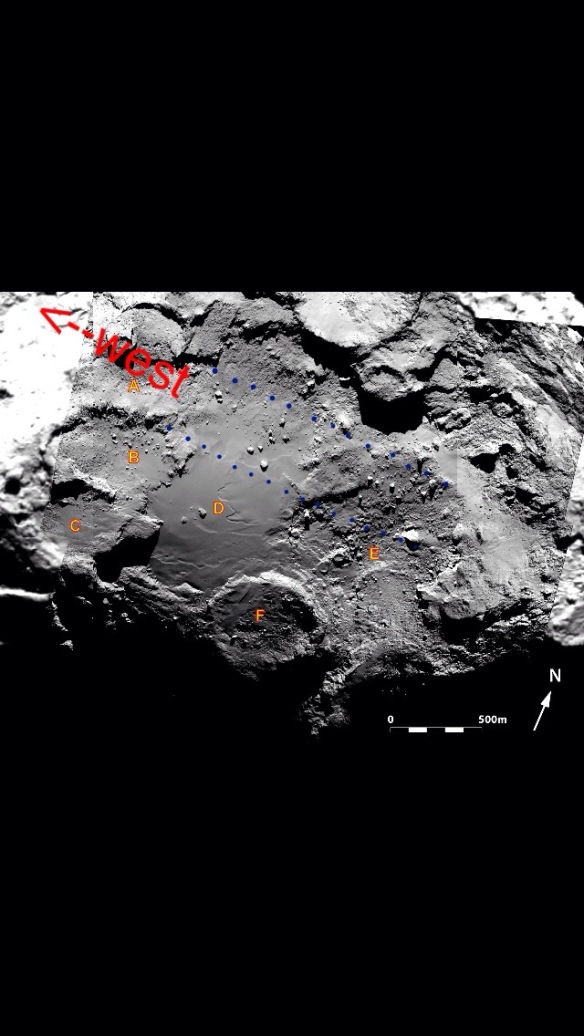AIRFALL BOULDERS ON THE IMHOTEP PLAIN (AND A PROVENANCE FOR CHEOPS). 
key:
Blue- a rotation plane corridor which runs parallel to the rotation plane of 67P. This also means it runs parallel to the equator which happens to run almost exactly along the lower blue line. These two lines are at 90° to the “North” arrow in the photo.
“west”- this is the direction which is opposite to the prograde rotation vector. So the Imhotep region moves from left to right from this point of view when rotating. That is, towards the east.
This page will eventually be expanded into a full post. The Imhotep plain has three small clutches of large boulders, including the largest, named Cheops, which is almost on the equator of 67P. It is proposed here that these boulders were detached during spin-up of the comet, most probably when the Imhotep slab departed. These boulders would have been the few pieces of detritus that received a chance backwards delta v velocity kick, possibly due to being only just about loosened out of their breccia matrix.
The backwards delta v put these rocks in to a suborbital trajectory instead of escape trajectory at 1 metre per second or more, like the slab. Being suborbital and on a longer, slower path than the comet surface rotating underneath them, they drifted back westward down the rotation plane. When they landed, they shed any scree riding on them westwards as well. You can see that this scree is indeed biased towards the west.
This process of rotation plane drift is the same as that described in Part 14 for rock A.
Regarding the two clutches within the corridor out on the flat, Imhotep plain you can see where they’ve come from. It’s the area of embedded but protruding boulders to the north of and including the very large boulder. That’s the one which is situated to the right of the ‘E’. The fact that some of the remnant boulders are embedded in the breccia matrix but protruding, supports the idea that these were on the cusp of being wrenched out by the Imhotep slab departing but survived in situ. This area of breccia is the hypothesised site of the slab hinge (Part 13). Those boulders out on the plain were the ones that were just on the other side of the cusp and so were only just pulled free from their matrix, hence their lazy drift backwards down the corridor in line with the rotation plane. All these rocks appear to be similarly reflective and with the same size distribution- both for the clutches and their source breccia.
The smaller clutch next to the ‘D’ can be tentatively traced back to a recess below the ‘E’ if they travelled the same distance down the rotation plane as the others. This recess has no visible breccia (in NAVCAM photos) but appears to have filled with slurry.
Notice how the Cheops boulder (the large rock that’s at the bottom of the upper clutch) is almost straight in line down the rotation plane from the very big embedded boulder. That boulder has a chipped-off end, the white section. If the volume of the chip is roughly extrapolated, it looks about the equivalent in size to Cheops and its two nearest companions. They are, again, similarly reflective. Since Cheops is only a fraction off the rotation plane line between the two, this is strong evidence that Cheops used to be part of the large, embedded boulder.
The above signatures can be seen only when one is looking at the comet photos with spin-up and stretch constantly in mind.
PHOTO CREDITS
Copyright ESA/Rosetta/NAVCAM – CC BY-SA IGO 3.0
To view a copy of this licence please visit:
http://creativecommons.org/licenses/by-sa/3.0/igo/
All dotted annotations by scute1133.
